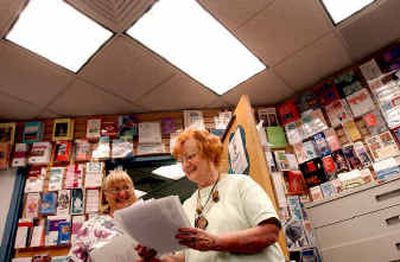DeArmond Health Library packed with information

A woman in her 40s, a 25-year-smoker, is looking for information on smoking cessation.
A girl considering having her breasts enlarged seeks information on breast augmentation.
Newly diagnosed patients want to understand their condition and treatment options.
All find the information they need at the DeArmond Consumer Health Library at Kootenai Medical Center, the only public health library in Idaho and the Inland Northwest that allows people to check out materials. There are other health libraries that are open to the public, but the DeArmond Library is the only one that circulates materials.
The tiny, 500-square-foot library is in the Health Resource Center, a smaller, blue building on the KMC campus. The library’s size belies its impact — it’s jampacked with health information. Brochures on a multitude of health conditions cover two walls, while the rest of library is filled with books, CDs and DVDs.
“We have 10,000 total items,” says Marcy Horner, director of library and grants development. She oversees both the DeArmond Library and the William T. Wood Medical Library for KMC staff.
“It looks like a small library, but we run 500 to 700 people through it (a month),” says Joan Hust, consumer health reference specialist, who’s been with the library since it opened in March 1996.
A donation from Richard and Jackie DeArmond funded the initial library collection and hardware. The hospital continues to fund the library, which is free to the public, while supplemental funding comes from the sale of T-shirts and a biannual book sale. The DeArmond Library functions as a branch of the Kootenai County library system.
The general public makes up about 80 percent of library users; patients account for the other 20 percent.
“Patients come down here with their IV poles,” Hust says. “It scares you when they come across the sidewalk with IV poles.”
“That’s why we deliver,” Horner added. The library offers “same-day service,” delivering information to patients at the hospital. There’s even a form that physicians can fill out with the diagnosis so patients know what to ask for.
“Sometimes we can’t read their writing, but it gives us a clue,” Horner jokes. “Otherwise patients come down here [and say] ‘I think I have …,’ ” she says, her facial expression mimicking their confusion.
Besides books and other materials, the library does online searches, using such Web sites as medlineplus.gov and medem.com.
“People prefer a search rather than going home with a book,” Hust says, adding that the library can e-mail information to nursing home residents who have computers.
But if it’s printed information people want, the library has that, too. Most popular are books on pregnancy and cookbooks for special diets. The library has a special teen collection on such topics as sexually transmitted diseases, tobacco, self-esteem and relationship issues. There’s also a collection for dealing with grief, which is used a lot by churches.
The library is collecting a series of first-person accounts of what it’s like the first year when you’ve been diagnosed with a particular condition. It’s called the “Patient Expert” series and covers such conditions as lupus, HIV, multiple sclerosis, type 2 diabetes and fibromyalgia.
The library has exercise videos and CDs. “Pilates runs off the shelf,” Horner says.
Then there are those materials people don’t want to be seen checking out.
“We don’t check out a lot of books on Viagra,” Hust says. “[People] just sit in the back and read them.”
The staff is ready and willing to help people locate information. “We’re not bashful,” says library clerk Jim Makovec, a retired Air Force nurse.
The library strives to be consumer-friendly. For instance, while it uses the National Library of Medicine classification system, which is different from the Dewey and Library of Congress systems, it has renamed the subject headings. Hence the big chart on the wall lists “Bugs” for pathology, “Heart” instead of cardiac and “Guts.”
The DeArmond library receives referrals from public libraries. There’s a “hesitation about asking someone not related to health care a personal question,” Horner says.
Adds Makovec: “We provide medical information, but we don’t make medical recommendations. We provide the information; the patient decides what to do.”
Three staff members, Hust, Makovec and Beth Hill, operate the library on a daily basis. Hill and Hust, besides having master’s degrees in library science, are certified by the Academy of Health Information Professionals.
The library recently won the Blue Ribbon Consumer Health Information Recognition Award for Libraries from the U.S. National Commission on Libraries and Information Science for promoting healthy lifestyles.
Staff members go beyond the walls of the library to promote health. They speak to support groups, schools, churches and other organizations and attend health information fairs.
However, there is one area in which they draw the line.
“We don’t march in parades,” Hust says.